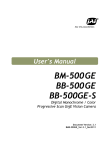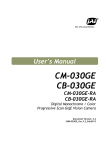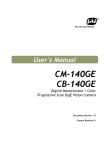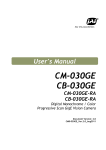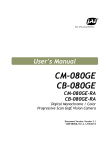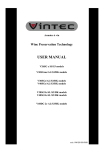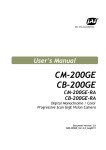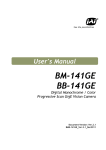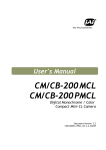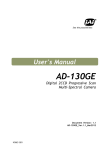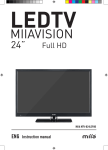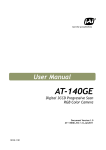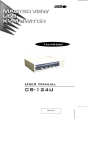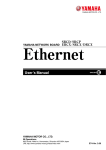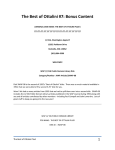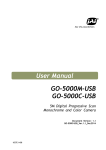Download User`s Manual - Stemmer Imaging
Transcript
User's Manual
CM-040GE
CB-040GE
CM-040GE-RA
CB-040GE-RA
Digital Monochrome / Color
Progressive Scan GigE Vision Camera
Document Version: 2.2
CMB-040GE_Ver.2.2_Feb2013
CM-040GE/CM-040GE-RA / CB-040GE/CB-040GE-RA
Notice
The material contained in this manual consists of information that is proprietary to JAI Ltd.,
Japan and may only be used by the purchasers of the product. JAI Ltd., Japan makes no
warranty for the use of its product and assumes no responsibility for any errors which may
appear or for damages resulting from the use of the information contained herein. JAI Ltd.,
Japan reserves the right to make changes without notice.
Company and product names mentioned in this manual are trademarks or registered
trademarks of their respective owners.
Warranty
For information about the warranty, please contact your factory representative.
Certifications
CE compliance
As defined by the Directive 2004/108/EC of the European Parliament and of the Council, EMC
(Electromagnetic compatibility), JAI Ltd., Japan declares that CM-040GE, CM-040GE-RA , CB040GE and CB-040GE-RA-RA comply with the following provisions applying to its standards.
EN 61000-6-3 (Generic emission standard part 1)
EN 61000-6-2 (Generic immunity standard part 1)
FCC
This equipment has been tested and found to comply with the limits for a Class B digital
device, pursuant to Part 15 of the FCC Rules. These limits are designed to provide reasonable
protection against harmful interference in a residential installation. This equipment
generates, uses and can radiate radio frequency energy and, if not installed and used in
accordance with the instructions, may cause harmful interference to radio communications.
However, there is no guarantee that interference will not occur in a particular installation. If
this equipment does cause harmful interference to radio or television reception, which can be
determined by turning the equipment off and on, the user is encouraged to try to correct the
interference by one or more of the following measures:
- Reorient or relocate the receiving antenna.
- Increase the separation between the equipment and receiver.
- Connect the equipment into an outlet on a circuit different from that to which the
receiver is connected.
- Consult the dealer or an experienced radio/TV technician for help.
Warning
Changes or modifications to this unit not expressly approved by the party
responsible for FCC compliance could void the user’s authority to operate the
equipment.
-2-
CM-040GE / CM-040GE-RA
Supplement
The following statement is related to the regulation on “ Measures for the Administration
of the control of Pollution by Electronic Information Products “ , known as “ China RoHS “.
The table shows contained Hazardous Substances in this camera.
mark shows that the environment-friendly use period of contained Hazardous
Substances is 15 years.
嶷勣廣吭並㍻
嗤蕎嗤墾麗嵎賜圷殆兆各式根楚燕
功象嶄鯖繁酎慌才忽佚連恢匍何〆窮徨佚連恢瞳麟半陣崙砿尖一隈〇云恢瞳ゞ 嗤蕎嗤
墾麗嵎賜圷殆兆各式根楚燕 〃泌和
桟隠聞喘豚㍉
窮徨佚連恢瞳嶄根嗤議嗤蕎嗤墾麗嵎賜圷殆壓屎械聞喘議訳周和音氏窟伏翌
亶賜融延、窮徨佚連恢瞳喘薩聞喘乎窮徨佚連恢瞳音氏斤桟廠夛撹冢嶷麟半
賜斤児繁附、夏恢夛撹冢嶷鱒墾議豚㍉。
方忖仝15々葎豚㍉15定。
CB-040GE / CB-040GE-RA
Supplement
The following statement is related to the regulation on “ Measures for the Administration
of the control of Pollution by Electronic Information Products “ , known as “ China RoHS “.
The table shows contained Hazardous Substances in this camera.
mark shows that the environment-friendly use period of contained Hazardous
Substances is 15 years.
嶷勣廣吭並㍻
嗤蕎嗤墾麗嵎賜圷殆兆各式根楚燕
功象嶄鯖繁酎慌才忽佚連恢匍何〆窮徨佚連恢瞳麟半陣崙砿尖一隈〇云恢瞳ゞ 嗤蕎嗤
墾麗嵎賜圷殆兆各式根楚燕 〃泌和
桟隠聞喘豚㍉
窮徨佚連恢瞳嶄根嗤議嗤蕎嗤墾麗嵎賜圷殆壓屎械聞喘議訳周和音氏窟伏翌
亶賜融延、窮徨佚連恢瞳喘薩聞喘乎窮徨佚連恢瞳音氏斤桟廠夛撹冢嶷麟半
賜斤児繁附、夏恢夛撹冢嶷鱒墾議豚㍉。
方忖仝15々葎豚㍉15定。
CM-040GE/CM-040GE-RA / CB-040GE/CB-040GE-RA
Table of Contents
JAI GigE® Vision Camera operation manuals ........................................................
Introduction .............................................................................................
Before using GigE Vision cameras.....................................................................
Software installation ...................................................................................
Camera operation ......................................................................................
1. General ...............................................................................................
2. Camera nomenclature ..............................................................................
3. Main Features ........................................................................................
4. Locations and Functions ............................................................................
-
6
6
6
6
7
7
7
8
9
-
4.1. CM-040GE and CB-040GE ................................................................................ - 9 4.2. CM-040GE-RA and CB-040GE-RA....................................................................... - 10 4.3. Rear panel indicator. ................................................................................... - 11 -
5. Pin Assignment ...................................................................................... - 12 5.1. 12-pin Multi-connector (DC-in/GPIO/Iris Video) ..................................................... - 12 5.2. Digital Output Connector for Gigabit Ethernet ...................................................... - 12 -
6. Input and output interface ....................................................................... - 13 6.1. GPIO interface ........................................................................................... - 13
6.1.1. LUT (Look Up Table) ............................................................................... - 13
6.1.2. 12-bit Counter ...................................................................................... - 14
6.1.3 Pulse Generators .................................................................................... - 14
6.2. Opto-isolated Inputs and outputs ...................................................................... - 15
6.2.1 Recommended External Input circuit diagram for customer .............................. - 16
6.2.2 Recommended External Output circuit diagram for customer ............................ - 16
6.2.3 Optical Interface Specifications ................................................................ - 17
6.3. Inputs and outputs table .............................................................................. - 17
6.4. Configuring the GPIO module .......................................................................... - 18
6.4.1. Input/Output Signal Selector.................................................................... - 18
6.5. Examples of the pulse generator configuration ................................................... - 18
6.5.1 Setting screen of the pulse generator ......................................................... - 18
6.5.2 GPIO in combination with Pulse Width trigger mode ....................................... - 19
6.5.3 Internal Trigger Generator ........................................................................ - 20
-
7. Image output signal ............................................................................... - 21 7.1. CCD Sensor Layout....................................................................................... - 21
7.2. Vertical Binning (CM-040GE/CM-040GE-RA only)................................................... - 21
7.3. Digital Video Output (Bit Allocation) ................................................................. - 22
7.3.1 Bit Allocation (Pixel Format/Pixel Type) – CM-040GE/-RA (monochrome) .............. - 22
7.3.1.1 GVSP_PIX_MONO8 (8bit) ....................................................................... - 22
7.3.1.2 GVSP_PIX_MONO10 (10bit) ................................................................... - 22
7.3.1.3 GVSP_PIX_MONO10_PACKED ( 10 bit ) ....................................................... - 22
7.3.2 Bit Allocation (Pixel Format / Pixel Type) – CB-040GE/-RA (Bayer) ...................... - 23
7.3.2.2 GVSP_PIX_BAYRG10 “Bayer RG10” ........................................................... - 23
7.3.2.3 GVSP_PIX_BAYGB8 “BayerGB8” .............................................................. - 23
7.3.2.4 GVSP_PIX_BAYGB10 “ BayerGB10” ........................................................... - 23
7.4. CB-040GE/CB-040GE-RA. Bayer filter ................................................................ - 24
7.5. Image timing ............................................................................................. - 25
7.5.1 Horizontal timing .................................................................................. - 25
7.5.2 Vertical timing ..................................................................................... - 25
7.5.3 Partial Scanning ................................................................................... - 26
7.5.4 Vertical binning .................................................................................... - 27
7.5.5 Auto Iris Lens video output (12-pin Hirose connector) ..................................... - 28
-
8. Network configuration ........................................................................... - 29 8.1. GigE Vision Standard Interface ......................................................................... - 29 -
-3-
CM-040GE/CM-040GE-RA / CB-040GE/CB-040GE-RA
8.2. Equipment to configure the network system ....................................................... - 29
8.2.1 PC .................................................................................................... - 29
8.2.2 Cables ............................................................................................... - 29
8.2.3 Network card (NIC) ................................................................................ - 29
8.2.4 Hub ................................................................................................... - 30
8.3. Recommended Network Configurations ............................................................. - 30
8.3.1 Guideline for network settings ................................................................. - 30
8.2.2 Video data rate (network bandwidth) ........................................................... - 31
8.3.3 Note for setting packet size ..................................................................... - 31
8.3.4 Calculation of Data Transfer Rate .............................................................. - 31
8.3.5 Simplified calculation (Approximate value) .................................................. - 32
8.3.6 Note for 100BASE-TX connection ............................................................... - 32
8.4. GigE camera connecting examples ................................................................... - 33
8.4.1 Using a switching hub for 1 port ................................................................ - 33
8.4.2 Connecting a camera to each port of a multi-port NIC ..................................... - 33
8.4.3 The data transfer for multiple cameras ....................................................... - 34
-
9. Functions and operations ........................................................................ - 36 9.1. Basic functions ........................................................................................... - 36 9.2. Electronic Shutter ....................................................................................... - 36 9.3. Auto-detect LVAL-synchronous / a-synchronous operation ...................................... - 37 -
10. Operation Modes ................................................................................. - 38 10.1. The functions related to GenICam SFNC 1.3 ...................................................... - 38
10.2. Operation Modes ....................................................................................... - 41
10.2.1 Continuous operation ........................................................................... - 41
10.2.2 Edge Pre-select Trigger Mode.................................................................. - 42
10.2.3 Pulse Width Control Trigger Mode ............................................................ - 44
10.2.4 Reset Continuous (RCT) trigger mode ........................................................ - 46
10.2.5 Sequential Trigger Mode (Pre-select trigger) ............................................... - 47
10.2.6 Delayed Readout Mode (Pre-select trigger) ................................................. - 49
10.2.7 Optical Black transfer mode ................................................................... - 50
10.2.8 Operation Mode and Functions matrix ....................................................... - 51
-
11. JAI control tool .................................................................................. - 52 11.1. About GenICamTMSFNC1.3 ............................................................................ - 52
11.2. JAI SDK Ver.1.3 ......................................................................................... - 52
11.3. Examples of camera operation ...................................................................... - 53
11.3.1 Generic cautions for operation ................................................................ - 53
11.3.2 Connection of camera(s) ....................................................................... - 53
11.3.3 Camera setting level ............................................................................ - 53
11.4. Input and Output settings ............................................................................ - 54
11.4.1 Interfacing with external devices ............................................................. - 54
11.4.2 Setting of input and output .................................................................... - 54
11.4.3 Setting the image size .......................................................................... - 55
11.4.4 Acquisition of the image ........................................................................ - 56
11.4.5 How to look at XML file ......................................................................... - 56
11.4.6 Feature Tree Information ...................................................................... - 56
11.4.7 Feature Properties (Guru) ..................................................................... - 57
-
12. External Appearance and Dimensions .......................................................... - 61 12.1. CM-040GE and CB-040GE .............................................................................. - 61 12.2. CM-040GE-RA and CB-040GE-RA ..................................................................... - 62 -
13. Specifications ..................................................................................... - 63 13.1. Spectral response ........................................................................................ - 63 11.2. Specification table ...................................................................................... - 64 -
14. Appendix .......................................................................................... - 66 14.1. Precautions .............................................................................................. - 66 14.2. Typical Sensor Characteristics ....................................................................... - 66 14.3. Caution when mounting a lens on the camera .................................................... - 66 -
-4-
CM-040GE/CM-040GE-RA / CB-040GE/CB-040GE-RA
14.4. Caution when mounting the camera ................................................................ - 67 14.5. Exportation .............................................................................................. - 67 14.6. References .............................................................................................. - 67 -
Change History ......................................................................................... - 68 User's Record ........................................................................................... - 69 -
-5-
CM-040GE/CM-040GE-RA / CB-040GE/CB-040GE-RA
JAI GigE® Vision Camera operation manuals
To understand and operate this JAI GigE® Vision camera properly, JAI provides the following
manuals.
User’s manual (this booklet)
JAI SDK & Control Tool User Guide
JAI SDK Getting Started Guide
Describes functions and operation of the hardware
Describes functions and operation of the Control Tool
Describes the network interface
User’s manual is available at www.jai.com
JAI SDK & Control Tool User Guide and JAI SDK Getting Started Guide are provided with the
JAI SDK which is available at www.jai.com.
Introduction
GigE Vision is a standard interface which uses Gigabit Ethernet for machine vision applications.
It was developed primarily by AIA (Automated Imaging Association) members. GigE Vision is
capable of transmitting large amounts of uncompressed image data through an inexpensive
general purpose LAN cable over long distances.
GigE Vision also supports the GenICamTM standard which is maintained by the EMVA (European
Machine Vision Association). The purpose of the GenICam standard is to provide a common
program interface for various machine vision cameras. By using GenICam, cameras from
different manufactures can seamlessly connect in one platform.
For details about the GigE Vision standard, please visit the AIA web site,
www.machinevisiononline.org and for GenICam, the EMVA web site, www.genicam.org.
JAI GigE Vision cameras comply with both the GigE Vision standard and the GenICam standard.
Before using GigE Vision cameras
All software products described in this manual pertain to the proper use of JAI GigE Vision
cameras. Product names mentioned in this manual are used only for the explanation of
operation. Registered trademarks or trademarks belong to their manufacturers.
To use the JAI SDK, it is necessary to accept the “Software license agreement” first.
This manual describes necessary equipment and the details of camera functions.
Software installation
The JAI GigE Vision SDK & Control Tool can be downloaded from the JAI web site at
www.jai.com. The JAI SDK is available for Windows XP and Vista, 32-bit and 64-bit.
For the details of software installation, please refer to the “Getting Started Guide” supplied
on the JAI SDK download page.
-6-
CM-040GE/CM-040GE-RA / CB-040GE/CB-040GE-RA
Camera operation
1. General
This manual covers the digital monochrome progressive scan camera CM-040GE/CM040GE-RA and color progressive scan camera CB-040GE/CB-040GE-RA
The CM-040GE/CM-040GE-RA/CB-040GE/CB-040GE-RA are a new additions to JAI GigE Vision
compliant camera series. Both the monochrome version CM-040GE/CM-040GE-RA and the
color version CB-040GE/CB-040GE-RA provide a frame rate of 61.15 frames/second at full
resolution in continuous operation. Using vertical binning (CM-040GE/CM-040GE-RA only) and
partial scan provides higher frame rates.
The 1/2" CCD with square pixels offers a superb image quality. The high-speed shutter
function and asynchronous random trigger mode allow the camera to capture high quality
images of fast moving objects.
The color version CB-040GE/CB-040GE-RA, based on CCD sensor with primary RGB Bayer
mosaic filter, outputs raw Bayer images. Host-based color interpolation is required to display
or save color images.
The CM-040GE/CM-040GE-RA/CB-040GE/CB-040GE-RA also comply with the GenICam standard
and contains an internal XML file that is used to describe the functions/features of the
camera. For further information about GigE®Vision standard, please go to
www.machinevisiononline.org and about GenICamTM, please go to www.emva.org.
As an application programming interface, JAI provides an SDK (Software Development Kit).
This SDK includes GigEVision Filter Driver,JAI control tool, software documentation and code
examples.
The JAI SDK can be downloaded from www.jai.com
The latest version of this manual can be downloaded from www.jai.com
For camera revision history, please contact your local JAI distributor.
2. Camera nomenclature
The standard camera composition consists of the camera main body and C-mount protection
cap.
The camera is available in the following versions:
CM-040GE/CM-040GE-RA
Where C stands for "Compact" family, M stands for "Monochrome", 040 represents the
resolution "400 thousand pixel", GE stands for "GigE Vision" interface and RA stands for Right
Angle type
CB-040GE/CB-040GE-RA
Where C stands for "Compact" family, B stands for "Bayer mosaic color", 040 represents the
resolution "400 thousand pixel", GE stands for "GigE Vision" interface and RA stands for Right
Angle type
-7-
CM-040GE/CM-040GE-RA / CB-040GE/CB-040GE-RA
3. Main Features
Member of Compact series, covering VGA to UXGA resolution
776 (h) x 582 (v) 8.3 µm square pixels
1/2” progressive scan – monochrome and Bayer mosaic color versions
High frame rate of 61.15 frames/second with full resolution in continuous operation
60 frames/second with external trigger and full resolution
+24dB Gain and noise reduction circuit built-in
Increased frame rate with vertical binning (CM-040GE/CM-040GE-RA only) and
partial scan
Exposure time from 54.874 μs to 2 sec. using Pulse Width trigger mode
Programmable exposure from 54.874 μs to 16.353 ms in Full Frame scan
Sequencer trigger mode for on-the –fly change of gain, exposure and ROI
Pre-select and Pulse width trigger mode
LVAL-synchronous/-asynchronous operation (auto-detect)
Auto iris lens video output allows a wider range of light (Can be Selected by DIP
switch )
GigE Vision Interface with 10 or 8-bit output
Programmable GPIO with opto-isolated inputs and outputs
Can be connected with 100BASE-TX
Right Angle type is available as CM-040GE-RA and CB-040GE-RA
Comprehensive software tools and SDK for Windows XP/Vista
Note: CM-040GE/CM-040GE-RA and CB-040GE/CB-040GE-RA can be connected with
100BASE-TX.
However, due to the limited bandwidth (100Mbps), the described
specifications such as frame rate, minimum trigger interval and so on can not
be satisfied for 100BASE-TX connection.
-8-
CM-040GE/CM-040GE-RA / CB-040GE/CB-040GE-RA
4. Locations and Functions
4.1.
CM-040GE and CB-040GE
Lens mount
CCD sensor
12-pin connector
RJ-45
LED
LED
LED
Holes for RJ-45 thumbscrews
Mounting holes
C-mount (Note *1)
1/2 inch CCD sensor
DC +12V to +24V power and GPIO interface
Gigabit Ethernet connector with threaded holes for
thumbscrews
Indication for power and trigger input
GigE Network condition : LINK
GigE Network condition : ACT
When an RJ-45 connector with thumbscrews is used,
remove the two screws located above and below the
Ethernet connector (Note*2)
M3 depth 3.5mm for tripod mount plate(Note*3)
*1) Note: Rear protrusion on C-mount lens must be less than 10.0mm.
*2) Note: When a RJ-45 cable with thumbscrews is connected to the camera, please do not
excessively tighten screws by using a screw driver. The RJ-45 receptacle on the
camera might get damaged. For security, the strength to tighten screws should be
less than 0.147 Newton meter (Nm). Tightening by hand is sufficient in order to
achieve this.
*3) Note: The depth of holes is 3.5mm. When the tripod adapter plate MP-40 or MP-41 is
used, use the attached screws. If installing the camera directly, please do not use
screws longer than 3.5mm.
Fig. 1. Locations
-9-
CM-040GE/CM-040GE-RA / CB-040GE/CB-040GE-RA
4.2. CM-040GE-RA and CB-040GE-RA
Lens mount
CCD sensor
12-pin connector
RJ-45
LED
LED
LED
Holes for RJ-45 thumbscrews
Mounting holes
C-mount (Note *1)
1/3 inch CCD sensor
DC +12V to +24V power and GPIO interface
Gigabit Ethernet connector with threaded holes for
thumbscrews
Indication for power and trigger input
GigE Network condition: LINK
GigE Network condition: ACT
When an RJ-45 connector with thumbscrews is used,
remove the two screws located above and below the
Ethernet connector (Note*2)
M3 depth 3.5mm for tripod mount plate (Note*3)
*1) Note: Rear protrusion on C-mount lens must be less than 10.0mm.
*2) Note: When a RJ-45 cable with thumbscrews is connected to the camera, please do not
excessively tighten screws by using a screw driver. The RJ-45 receptacle on the
camera might get damaged. For security, the strength to tighten screws is less than
0.147 Newton meter (Nm). Tightening by hand is sufficient in order to achieve this.
*3) Note: The depth of holes is 3.5mm. When the tripod adapter plate MP-40 or MP-41 is used,
use the attached screws. If installing the camera directly, please do not use screws
longer than 3.5mm.
Fig.2 Locations (CM-040GE-RA / CB-040GE-RA)
- 10 -
CM-040GE/CM-040GE-RA / CB-040GE/CB-040GE-RA
4.3. Rear panel indicator.
The rear panel mounted LED provides the following information:
Amber: Power connected - initiating
Steady green: Camera is operating in Continuous mode
Flashing green: The camera is receiving external trigger
Ethernet connector indicates,
Steady green : 1000 Base-T has been connected
Flashing green : 100 Base-TX has been connected
Flashing amber : Network active in communication
Fig.3. Rear Panel
Note: When 10BASE-T is connected, the green is also flashing.
However, the video is not streamed through Ethernet.
- 11 -
CM-040GE/CM-040GE-RA / CB-040GE/CB-040GE-RA
5. Pin Assignment
5.1. 12-pin Multi-connector (DC-in/GPIO/Iris Video)
Type: HR10A-10R-12PB (Hirose) male.
(Seen from rear of
Pin no.
Signal
Remarks
camera)
1
GND
+12V to +24V
2
DC input
3
Opt IN 2 (-) / GND (*1)
4
Opt IN 2 (+)/Iris Video out (*1)
9
1
2
8
10
5
Opt IN 1 ( - )
3 11 12 7
6
Opt IN 1 ( + )
GPIO IN / OUT
4
6
7
Opt Out 1 ( - )
5
8
Opt Out 1 ( + )
9
Opt Out 2 ( - )
10
Opt Out 2 ( + )
+12V to +24V
11
DC input
12
GND
Fig.4. 12-pin connector.
*1 : Iris Video output function can be set by the internal DIP
switch.
5.2. Digital Output Connector for Gigabit Ethernet
Type: RJ-45
HFJ11-1G02E-L21RL or equivalent
The CM-040GE/CM-040GE-RA and CB-040GE/CB-040GE-RA cameras
also accept industrial RJ-45 connectors with thumbscrews. This
assures that the connector does not come undone in tough industrial
environments.
Please contact the nearest JAI distributor for details on
recommended industrial RJ-45 connectors.
Fig. 5. Gigabit Ethernet connector
The digital output signals follow the Gigabit Ethernet interface using RJ-45 conforming
connector. The following is pin assignment for Gigabit Ethernet connector.
Pin No
1
2
3
4
5
6
7
8
In/Out
In/Out
In/Out
In/Out
In/Out
In/Out
In/Out
In/Out
In/Out
Name
MX1+ (DA+)
MX1- (DA-)
MX2+ (DB+)
MX3+ (DC+)
MX3- (DC-)
MX2- (DB-)
MX4+ (DD+)
MX4- (DD-)
- 12 -
CM-040GE/CM-040GE-RA / CB-040GE/CB-040GE-RA
6. Input and output interface
6.1. GPIO interface
All input and output signals pass through the GPIO (General Purpose Input and Output) module.
The GPIO module consists of a Look-Up Table (LUT – Cross-Point Switch), 4 Pulse Generators
and a 12-bit counter. In the LUT, the relationship between inputs, counters and outputs is
governed by internal register set-up.
Digital I/O(GPIO) setting
0
1
2
3
4
5
LVAL IN
DVAL IN
FVAL IN
EEN IN
OPT IN 1
OPT IN 2
12
13
14
15
Soft Trigger 0
16
17
18
19
Pulse
Pulse
Pulse
Pulse
Digital I/O(GPIO) setting
Soft Trigger 3
Generator
Generator
Generator
Generator
0
1
1
1
Pulse Generator 3
(20 bit Counter )
OUT
16
Pulse Generator 0
Pulse Generator 1
Pulse Generator 2
Pulse Generator 3
12
13
14
15
Setting for
Line Selector
Pulse Generator Setting 3
Pulse Generator 1
(20 bit Counter )
IN
Pulse Generator Setting 2
Pulse Generator 0
(20 bit Counter )
Pixel Clock
Time Stamp Reset
( Cross Point Switch )
Soft Trigger 1
Soft Trigger 2
Pulse Generator 2
(20 bit Counter )
1
0
1
4
5
LUT
Setting for
Line Source
Counter Clock Source
0
25 MHz
TRIGGER 0
TRIGGER 1
PORT 1 1
PORT
2
Pulse Generator Setting 1
Pulse Generator Setting 0
Length counter 0
Start Point Counter 0 ( 1)
Start Point Counter 0 (2) for repeat
End point counter 0
Counter 0 clear
12 bit
Counter
Counter Divide by value
0
Bypass
1 - 4095 1/2 to 1/4096
The input and output settings for the
follows.
Line
Signal
Line 3
Optical Out 1
Line 4
Optical Out 2
Line 5
Optical In 1
Line 6
Optical In 2
Fig.6 GPIO block
CM-040GE and CB-040GE series have been fixed as
Connector
Hirose 12P pin
Hirose 12P pin
Hirose 12P pin
Hirose 12P pin
#
#
#
#
7/8
9/10
5/6
3/4
6.1.1. LUT (Look Up Table)
The LUT works as a cross-point switch, which allows connecting inputs and outputs freely.
The signals LVAL_IN, DVAL_IN, FVAL_IN and EEN_IN all originate from the camera timing
circuit.
Trigger 0 is connected to the camera’s timing circuit and is used for initiating triggered
exposure. Trigger 1 is used for Delayed Readout mode. The Time Stamp Reset signal is used to
reset the camera’s time stamp function, also making it possible to reset and synchronize the
time stamp of multiple cameras.
- 13 -
CM-040GE/CM-040GE-RA / CB-040GE/CB-040GE-RA
6.1.2. 12-bit Counter
A 25MHz clock or the camera pixel clock (33.75MHz) can be used as a source. The counter has
a “Divide by N”, where N has the range 1 through 4096, allowing a wide range of clock
frequencies to be programmed. Setting Value 0 is bypass, setting value 1 is 1/2 dividing and
setting value 4095 is 1/4096 dividing.
6.1.3 Pulse Generators (0 to 3)
Each pulse generator consists of a 20bit counter. The behavior of these signals is defined by
their pulse width, start point, end point and number of repetitions.
The pulse generator signals can be set in either triggered or periodic mode.
In triggered mode, the pulse is triggered by the rising edge/falling edge/high level or low
level of the input signal.
In periodic mode, the trigger continuously generates a signal that is based on the configured
pulse width, starting point and end point.
Start Point
End Point
Length
Fig.7 Generated pulse
Setting example:
The following example shows the FVAL input to pulse generator. The pulse generator creates
the pulse using FVAL and the pulse is output through GPIO PORT 1.
Pulse Generator Setting Example
Pulse Generator Clear = 4: Rising Edge
Pulse Generator 0
(FVAL )
IN
Clock IN
Clock Source=Pixel Clock ( 60MHz)
Clock Pre-scaler = 2399 ⇒ 25KHz
0
1
2
3
99 100 101 102 103
1/25KHz = 40µs
Start Point = 0
Pulse Generator 0
OUT
(GPIO Port 1 )
End Point = 99
1
2
Length = 102
1
Repeat counter: 0 to 255
=0: Continuously repeated
Fig 9. Pulse generator setting example
The created pulse rises up at the start point and falls down at the end point as show above.
Accordingly, the High duration is (End point – Start point) clocks x (1/ Pulse gen. frequency).
In the above example, the original oscillation uses pixel clock (60 MHz) and the pixel clock is
divided by 2400, a pulse frequency of the generator is 25 KHz (60000000/2400). As the start
point is 0 and the end point is 99, the pulse having 100 x 1/25000 = 4ms width is created.
- 14 -
CM-040GE/CM-040GE-RA / CB-040GE/CB-040GE-RA
If the HIGH duration needs to be delayed against incoming trigger, the start point should be
set at “N“. The delay value is N x (1/ 25000).
In the above example, the N is “0” which is no delay.
The length, in this case, is 102 clocks.
These settings can be achieved by JAI Control tool which is the part of JAI SDK.
6.2. Opto-isolated Inputs and outputs
The control interface of the C3 GigE Vision camera series has opto-isolated inputs and outputs,
providing galvanic separation between the camera’s inputs /outputs and peripheral
equipment. In addition to galvanic separation, the opto-isolated inputs and outputs can cope
with a wide range of voltages; the voltage range for inputs is +3.3V to +24V whereas outputs
will handle +5V to +24V.
The below figures shows the functional principle (opto-coupler) of the opto-isolated inputs
and outputs.
Fig.9. Photo coupler
- 15 -
CM-040GE/CM-040GE-RA / CB-040GE/CB-040GE-RA
6.2.1 Recommended External Input circuit diagram for customer
Fig.10 External Input Circuit, OPT IN 1 and 2
6.2.2 Recommended External Output circuit diagram for customer
Fig.11. External Output Circuit, OPT OUT 1 and 2
- 16 -
CM-040GE/CM-040GE-RA / CB-040GE/CB-040GE-RA
6.2.3 Optical Interface Specifications
The relation of the Input signal and the output signal through optical interface is as follows.
Conditions for Input
Input Line Voltage Range
+3.3v ~ +24V
Input Current
6mA ~ 30mA
Minimum Input Pulse Width to Turn ON
0.5us
Output Specifications
Output Load(Maximum Current)
100mA
Minimum Output Pulse Width
20us
Time Delay Rise TDR
0.5us ~ 0.7us
Rise Time
RT
1.2us ~ 3.0us
Time Delay Fall TDF
1.5us ~ 3.0us
Fall Time
FT
4.0us ~ 7.0us
Fig.12. Opto-isolated Interface Performance
6.3.
Inputs and outputs table
Input Port
Output Port
OPT
OUT1
OPT
OUT2
×
×
×
Time
Stamp
Reset
×
×
×
×
×
×
×
×
×
EEN IN
×
×
○
OPT IN 1
○
○
OPT IN 2
○
Soft Trigger 0
○
Soft Trigger 1
Trigger 0
Trigger 1
LVAL IN
×
DVAL IN
FVAL IN
Pulse
Gen. 0
Pulse
Gen. 1
Pulse
Gen. 2
Pulse
Gen. 3
○
○
○
○
×
○
○
○
○
×
○
○
○
○
○
×
○
○
○
○
○
○
○
○
○
○
○
○
○
○
○
○
○
○
○
○
○
○
○
○
○
○
○
○
○
○
○
○
○
○
○
○
Soft Trigger 2
○
○
○
○
○
○
○
○
○
Soft Trigger 3
○
○
○
○
○
○
○
○
○
Pulse Gen. 0
○
○
○
○
○
×
○
○
○
Pulse Gen. 1
○
○
○
○
○
○
×
○
○
Pulse Gen. 2
○
○
○
○
○
○
○
×
○
Pulse Gen. 3
○
○
○
○
○
○
○
○
×
LEGEND : 0 = valid combination / x = Not valid ( do not use this combination )
- 17 -
CM-040GE/CM-040GE-RA / CB-040GE/CB-040GE-RA
6.4. Configuring the GPIO module
6.4.1. Input/Output Signal Selector
Line selector
This sets the input and output to the external equipment. Line 3 through line 6 are already
allocated as below.
Line source
This sets which signal can be fed through selected output, external or internal.
6.5.
Examples of the pulse generator configuration
6.5.1 Setting screen of the pulse generator
- 18 -
CM-040GE/CM-040GE-RA / CB-040GE/CB-040GE-RA
6.5.2 GPIO in combination with Pulse Width trigger mode
Example: 20 µs unit pulse width exposure control (PWC).
Pixel clock is 33.75 MHz. 675 clocks (775-100) equals 20 µs.
Feature
Value
c)Acquisition
and Trigger
Trigger Mode
ON
Trigger controls
selector
JAI Acquisition and JAI Exposure
Pulse width control
Trigger Control
Mode
Pulse Generators
Pulse
Pulse Generator 0 Selector Line 5 =OPT IN 1
Generator
selector
Clock Choice
1
=
Pixel
Clock
(33.75MHz)
Counter Dividing Value
0 = Pass through
Length Counter 0
1000 Clocks
Start point Counter 0
100 Clocks
Repeat Count 0
1
End point Counter 0
775 Clocks
Counter Clear 0
Rising Edge
Trigger source
pulse generator 0
LVAL IN
DVAL IN
FVAL IN
EEN IN
Trigger 0
Trigger 1
LUT
OPT IN 1
OPT IN 2
Soft Trigger 0
Soft Trigger 1
Soft Trigger 2
Soft Trigger 3
OPT OUT 1
OPT OUT 2
Time Stamp Reset
(Cross point switch)
(
( Cross Point Switch )
Pulse Generator 3
(20bit Counter)
Pulse Generator 2
(20bit Counter)
Pulse Generator 1
(20bit Counter)
Pulse Generator 0
(20bit Counter)
25 MHz
Pixel Clock
12bit
12bit
OPT IN 1
Counter
Counte
Pulse Generator 0
output
100
750
1000
Fig.13. Pulse Generator Timing Example 1
- 19 -
CM-040GE/CM-040GE-RA / CB-040GE/CB-040GE-RA
6.5.3 Internal Trigger Generator
Create a trigger signal and trigger the camera
Feature
c)Acquisition
and Trigger
Trigger Mode
Trigger controls
selector
Pulse Generators
Pulse
Pulse Generator 0 Selector
Generator
selector
Clock Choice
Counter Dividing Value
Length Counter 0
Start point Counter 0
Repeat Count 0
End point Counter 0
Clear activation
Trigger source
Value
ON
1
=
Pixel
Clock
(33.75Hz)
926(line rate)
1000 Clocks
100 Clocks
0
500 Clocks
Off
pulse generator 0
LVAL IN
DVAL IN
FVAL IN
EEN IN
Trigger 0
Trigger 1
LUT
OPT IN 1
OPT IN 2
Soft Trigger 0
Soft Trigger 1
Soft Trigger 2
Soft Trigger 3
OPT OUT 1
OPT OUT 2
Time Stamp Reset
(Cross point switch)
(
( Cross Point Switch )
Pulse Generator 3
(20bit Counter)
Pulse Generator 2
(20bit Counter)
Pulse Generator 1
(20bit Counter)
Pulse Generator 0
(20bit Counter)
25 MHz
Pixel Clock
12bit
12bit
Counter
Counte
Line Rate 36.447KHz
(33.75MHz)
Pulse Generator 0
output
100 Line
500 Line
1000 Line
Fig.14. Pulse Generator 0 timing Example 2
- 20 -
CM-040GE/CM-040GE-RA / CB-040GE/CB-040GE-RA
7. Image output signal
7.1. CCD Sensor Layout
The CCD sensor layout with respect to pixels and lines used in the timing and video full frame
read out is shown below.
OB
Active Pixels Output
Video Output
776 (H) x 582 (V)
2
582
592
Pixel ( 1,1 )
R G
G B
R G
OB
OB
610
2
823
OB
OB
3 6
776
38
40
16
OB, 6 lines for vertical
and 16 Pixels for
horizontal can be
transferred on OB
Transfer mode.
Fig. 19. CCD sensor layout
Important Note: By using the Optical Black (OB) transfer mode, the user can select whether
to include optical black pixels in the image stream.
7.2. Vertical Binning (CM-040GE/CM-040GE-RA only)
The binning function can be used to achieve
higher frame rate or higher sensitivity. The
drawback is lower resolution.
Vertical binning is done by adding the charge
from pixels in adjacent lines in the horizontal
CCD register.
Fig. 13 shows the binning principle. Resolution
and frame rate for all combinations are shown
in the below table.
H
Xsg1
No V binning
V binning
Video out
Fig.16. CM-040GE/CM-040GE-RA binning.
The CM-040GE/CM-040GE-RA has ON or OFF function for Vertical Binning:
Setting
Value for Register address 0xA084 Resolution
Off (no binning)
0x01
776(h) x 582(v)
2:1 binning
0x02
776(h) x 291(v)
- 21 -
Frame rate
61.15 fps
111.019 fps.
CM-040GE/CM-040GE-RA / CB-040GE/CB-040GE-RA
7.3. Digital Video Output (Bit Allocation)
Although the CM-040GE/CM-040GE-RA and CB-040GE/CB-040GE-RA are digital cameras, the
image is generated by an analog component, the CCD sensor.
The table and diagram below show the relationship between the analog CCD output level and
the digital output.
CCD out
Analog Signal * Digital Out(10-bit)
Black
Setup 3.6%, 25mV
32LSB
200mV
700mV
890LSB
230mV
800mV
1023LSB
The standard setting for 10-bit video level is 890 LSB. 200 mV CCD output level equals 100%
video output.
1023
White Clip Level
100% Level
Digital Out [LSB]
890
32
0
Black Level
25
Analog Signal [mV]
700 800
Fig. 17. Digital Output
7.3.1 Bit Allocation (Pixel Format/Pixel Type) – CM-040GE/-RA (monochrome)
In the GigE Vision Interface, GVSP (GigE Vision Streaming Protocol) is used for an application
layer protocol relying on the UDP transport layer protocol. It allows an application to receive
image data, image information and other information from a device.
In the monochrome camera, CM-040GE/CM-040GE-RA, the following pixel types supported by
GVSP are available. With regard to the details of GVSP, please refer to GigE Vision
Specification available from AIA (www.machinevisiononline.org).
7.3.1.1 GVSP_PIX_MONO8 (8bit)
1Byte
2Byte
3Byte
Y0
Y1
Y2
0 1 2 3 4 5 6 7 0 1 2 3 4 5 6 7 0 1 2 3 4 5 6 7
7.3.1.2 GVSP_PIX_MONO10 (10bit)
1Byte
2Byte
3Byte
4Byte
Y0
Y0
Y1
Y1
0 1 2 3 4 5 6 7 8 9 X X X X X X 0 1 2 3 4 5 6 7 8 9 X X X X X X
7.3.1.3 GVSP_PIX_MONO10_PACKED ( 10 bit )
Y0
Y1
Y2
Y3
2 3 4 5 6 7 8 9 0 1 X X 0 1 X X 2 3 4 5 6 7 8 9 2 3 4 5 6 7 8 9 0 1 X X 0 1 X X 2 3 4 5 6 7 8 9
- 22 -
CM-040GE/CM-040GE-RA / CB-040GE/CB-040GE-RA
Address
0xA410
Internal Name
Pixel Format type
Access
Size
R/W
4
Value
0x01080001:Mono8
0x01100003:Mono10
0x010C0004:Mono10 Packed
7.3.2 Bit Allocation (Pixel Format / Pixel Type) – CB-040GE/-RA (Bayer)
In the Bayer mosaic color camera, CB-040GE/CB-040GE-RA, the following pixel types
supported by GVSP(GigE Vision Streaming Protocol) are available.
With regard to the details of GVSP, please refer to GigE Vision Specification available from
AIA (www.machinevisiononline.org)
7.3.2.1 GVSP_PIX_BAYRG8 “ BayerRG8 “
Odd Line
1 Byte
2 Byte
3 Byte
R0
G1
R2
0 1 2 3 4 5 6 7 0 1 2 3 4 5 6 7 0 1 2 3 4 5 6 7
Even Line
G0
B1
G2
0 1 2 3 4 5 6 7 0 1 2 3 4 5 6 7 0 1 2 3 4 5 6 7
7.3.2.2 GVSP_PIX_BAYRG10 “Bayer RG10”
Odd Line
1 Byte
2 Byte
3 Byte
4 Byte
R0
R0
G1
G1
0 1 2 3 4 5 6 7 8 9 X X X X X X 0 1 2 3 4 5 6 7 8 9 X X X X X X
Even Line
G0
G0
B1
B1
0 1 2 3 4 5 6 7 8 9 X X X X X X 0 1 2 3 4 5 6 7 8 9 X X X X X X
7.3.2.3 GVSP_PIX_BAYGB8 “BayerGB8”
Odd Line
G0
B1
G2
0 1 2 3 4 5 6 7 0 1 2 3 4 5 6 7 0 1 2 3 4 5 6 7
Even Line
R0
G1
R2
0 1 2 3 4 5 6 7 0 1 2 3 4 5 6 7 0 1 2 3 4 5 6 7
7.3.2.4 GVSP_PIX_BAYGB10 “ BayerGB10”
Odd Line
1 Byte
2 Byte
3 Byte
4 Byte
G0
G0
B1
B1
0 1 2 3 4 5 6 7 8 9 X X X X X X 0 1 2 3 4 5 6 7 8 9 X X X X X X
Even Line
R0
R0
G1
G1
0 1 2 3 4 5 6 7 8 9 X X X X X X 0 1 2 3 4 5 6 7 8 9 X X X X X X
- 23 -
CM-040GE/CM-040GE-RA / CB-040GE/CB-040GE-RA
Address
0xA410
Note:
Internal Name
Pixel Format type
Access
Size
R/W
4
Value
0x01080009:BAYRG8
0x0108000A: BAYGB8
0x0110000D:BAYRG10
0x0110000E:BAYGB10
CB-040GE/CB-040GE-RA has the same Bayer sequence for Full and any of partial
scanning as RG. Therefore, comparing full scanning and partial scanning, the center
might be shifted.
As the Pixel Format type, CB-040GE/CB-040GE-RA supports BAYER GB 8 and BAYER GB
10. When this type is selected, the output starts from 2nd line for all scanning.
7.4. CB-040GE/CB-040GE-RA. Bayer filter
FVAL Timing
CB-040GE/CB-040GE-RA is a color camera based on a
CCD sensor with a Bayer RGB color mosaic. The color
image reconstruction is done in the host PC.
The Color sequence in the video signal is the same
for all scanning formats.
Actual V Line #
1
The line readout follows LVAL.
The first valid pixel is the same timing as DVAL.
The Bayer color sequence starts with:
GBG for even line numbers
RGR for odd numbers
Figure 18 shows the timing sequence for the Bayer
mosaic read-out for the available partial scan modes
Line # from FVAL raising edge
9
1
R G R
G B G
Full
13
97
R G R
G B G
2/3 Partial
17
145
R B
G
G R
G
R B R
G
G
1/2 Partial
24
219
R G R
G B G
1/4 Partial
27
255
R G R
G B G
1/8 Partial
LVAL
1
DVAL
6 ck
Fig.18. Bayer layout for each scan mode
- 24 -
CM-040GE/CM-040GE-RA / CB-040GE/CB-040GE-RA
7.5. Image timing
7.5.1 Horizontal timing
The LVAL period is shown for normal continuous mode.
Fig. 19. Horizontal timing
7.5.2 Vertical timing
The FVAL period for normal continuous mode full scan is shown.
Fig. 20. Vertical timing for full scan
- 25 -
CM-040GE/CM-040GE-RA / CB-040GE/CB-040GE-RA
7.5.3 Partial Scanning
The FVAL period is shown for 1/2 partial scan in normal continuous mode.
7.5.3.1 Vertical Timing
The below diagram and table provide vertical timing information for the fixed partial scan
settings 1/2, 1/4, 1/8 and 2/3
Values for vertical timing in partial scan continuous mode.
1/2
FVAL
Low (L)
6
A
(L)
16
1/4
6
23
1/8
6
26
2/3
6
12
AREA
B (L)
Start line End line
294
145
438
146
219
364
74
255
328
390
97
486
C
(L)
14 L
Total
line
(L) L
330
frame
rate
(fps)
110
20 L
195L
186
24 L
130 L
280
9L
417L
87
Fig. 21. Vertical timing for partial scanning
- 26 -
CM-040GE/CM-040GE-RA / CB-040GE/CB-040GE-RA
7.5.3.2 Horizontal Timing
The horizontal timing is the same the full scanning.
Fig.22. Horizontal Timing for Partial Scanning
7.5.4 Vertical binning
Vertical binning combines charge from two adjacent lines, reducing the vertical resolution to
half and at the same time increasing frame rate or sensitivity. By activating this function, the
frame rate is increased to 111.019 fps.
This function is available only for CM-040GE/CM-040GE-RA.
Important Note
Vertical Binning cannot be used together with the Partial Scanning.
Horizontal Timing
V Binning
Horizontal Timing
1LVAL 1010 ck = 29.925 us
1ck=
29.629629ns
LVAL
DATA OUT
Valid data
OB
782 ck
38ck
190 ck
820 ck
DVAL
776 ck
16 ck
6 ck
Fig.23. Horizontal Timing for Vertical Binning
- 27 -
CM-040GE/CM-040GE-RA / CB-040GE/CB-040GE-RA
7.5.4.1 Vertical timing
V binning
FRAME RATE
301 L 111.019 fps
LVAL
FVAL
579+ 580
1+2 3+4
DAVL
6L
4L
581 + 582
291 L
OB
Valid data
OB
2L
DATA
CCD Exposure
EEN
Fig.24. Vertical Timing for Vertical Binning
7.5.5 Auto Iris Lens video output (12-pin Hirose connector)
This analogue signal is not routed through the GPIO.
This signal is available at pin 4 of 12-pin Hirose connector. It
can be used for lens iris control in Continuous and RCT modes
only.
The signal is taken from the CCD sensor and is output after the
gain circuit. The video output is
without sync.
The signal is 0.7 V p-p from <400 AC coupled.
Fig 25. Video output circuit
+5V
0.1μ
2K2
1K
IRIS Video Out
1μ
DAC
930
700
100% Level
Analog Out [mV]
To use this signal, the internal DIP switch must be set
as follows.
The auto-iris lens video
output is enabled by
setting switch SW600 to
ON (two switches to the
left). The internal DIP
switch is set to OFF (two
switches to the right) as
factory default.
0
CCD Out [mV]
200
265
Fig.26 Iris video output
- 28 -
CM-040GE/CM-040GE-RA / CB-040GE/CB-040GE-RA
8. Network configuration
For details of the network settings, please refer to the “Getting Started
Guide” supplied with the JAI SDK.
8.1. GigE Vision Standard Interface
The CM-040GE/CM-040GE-RA and CB-040GE/CB-040GE-RA are designed in accordance with the
GigE Vision standard. It transmits digital images over Cat5e or Cat6 Ethernet cables. All
camera functions are also controlled via the GigE Vision interface.
The camera can operate in continuous mode, providing an endless stream of images. For
capturing individual images, related to a specific event, the camera can also be triggered. For
precise triggering, it is recommended to use a hardware trigger applied to the Hirose 12-pin
connector. It is also possible to initiate a software trigger through the GigE Vision interface.
However, when using software trigger, certain latency inherent to the GigE interface must be
anticipated. This latency, that manifests itself as jitter, greatly depends on the general
conditions and traffic on the GigE connection. The frame rate described in this manual is for
the ideal case and may deteriorate depending on conditions.
When using multiple cameras (going through a switch and/or a single path) or when operating
in a system with limited transmission bandwidth the Delayed Readout Mode and Inter-Packet
Delay functions can be useful.
8.2. Equipment to configure the network system
8.2.1 PC
The PC used should have the following performance or better
1) Recommended CPU
: Core2 Duo 2.4GHz or better,
Better than Core2 Extreme
2) Recommended memory
: 2Gbyte or more
3) Video card
: Better than PCI Express Bus Ver.1.0 x16
VRAM should be better than 256MByte, DDR2
4) Other
: The resident software should not be used
8.2.2 Cables
GigEVision configures the system by using 1000BASE-T. (100BASE-T can be used with
some restriction. Refer to chapter 8.3.6). In the market, CAT5e (125MHz), CAT6
(250MHz) and CAT7 (600MHz) cables are available for 1000BASE-T. There are
crossover cables and straight through cables available. Currently, as most equipment
complies with Auto MDI/MDI-X, please use straight through cables. (Among crossover
cables, a half crossover type exists, which the Ethernet will recognize as 100BASE-T).
8.2.3 Network card (NIC)
The network card should comply with 1000BASE-T and also have the capability of
JUMBO FRAMES. When the jumbo frame size is set at a larger number, the load on the
CPU will be decreased. Additionally, as the overhead of the packet is decreased, the
transmission will have more redundancy.
- 29 -
CM-040GE/CM-040GE-RA / CB-040GE/CB-040GE-RA
JAI confirms the following network cards.
NIC
PCI-X Bus
Manufacture Type
Intel
PRO/1000MT
Server Adapter
Intel
PRO/1000MT Dual Port
Server Adapter
Intel
PRO/1000GT Quad
Port
Server Adapter
Intel
PRO/1000PT
―
Server Adapter
Intel
Pro/1000 CT
―
Desktop adaptor
Intel
Gigabit ET2 Quad port
―
Server Adapter
Intel
Gigabit ET Dual port
―
Server Adapter
Intel
Gigabit EF Dual port
―
Server Adapter
PCI-Express
Bus
( x1 )
( x1 )
( x4 )
( x4 )
( x4 )
32bit or 64bit
33/66/100/133 MHz
32bit or 64bit
33/66/100/133 MHz
32bit or 64bit
66/100/133 MHz
2.5Gbps uni-directional
5Gbps bi-directional
2.5Gbps uni-directional
5Gbps bi-directional
10Gbps uni-directional
20Gbps bi-directional
10Gbps uni-directional
20Gbps bi-directional
10Gbps uni-directional
20Gbps bi-directional
8.2.4 Hub
It is recommended to use the metal chassis type due to the shielding performance.
As the hub has a delay in transmission, please note the latency of the unit.
8.3. Recommended Network Configurations
Although the CM-140GE and CB-140GE series conform to Gigabit Ethernet (IEEE 802.3)
not all combinations of network interface cards (NICs) and switches/routers are
suitable for use with the GigE Vision compliant camera.
JAI will endeavor to continuously verify these combinations, in order to give users the
widest choice of GigE components for their system design.
For details of the network settings, please refer to the “Getting Started
Guide” supplied with the JAI SDK.
8.3.1 Guideline for network settings
To ensure the integrity of packets transmitted from the camera, it is recommended to
follow these simple guidelines:
1. Whenever possible use a peer-to-peer network.
2. When connecting several cameras going through a network switch, make sure it is
capable of handling jumbo packets and that it has sufficient memory capacity.
3. Configure inter-packet delay to avoid congestion in network switches.
4. Disable screen saver and power save functions on computers.
5. Use high performance computers with multi-CPU, hyper-thread and 64-bit CPU,
etc.
6. Only use Gigabit Ethernet equipment and components together with the camera.
7. Use at least Cat5e and preferably Cat6 Ethernet cables.
8. Whenever possible, limit the camera output to 8-bit.
- 30 -
CM-040GE/CM-040GE-RA / CB-040GE/CB-040GE-RA
8.2.2 Video data rate (network bandwidth)
The video bit rate for CM-040GE/CM-040GE-RA and CB-040GE/CB-040GE-RA is:
Model
Pixel Type
CM-040GE/CM040GE-RA
MONO8
MONO10_PACKED
MONO10
BAYRG8,BAYGB8
BAYRG10,BAYBG10
CB-040GE/CB040GE-RA
Packet data volume
(In case the Packet size is 1500)
200 Mbit/s
300 Mbit/s
400 Mbit/s
200 Mbit/s
400 Mbit/s
In case of using Jumbo Frame, the packet data will be improved by 2 %.
For CM-040GE/CM-040GE-RA and CB-040GE/CB-040GE-RA, the jumbo frame can be set at
maximum 4040 Bytes (Factory setting is 1428 Byte). To set Jumbo Frame, refer chapter 8.2.4.
8.3.3 Note for setting packet size
The packet size is set to 1428 as the factory default. Users may enter any value for the
packet size and the value will be internally adjusted to an appropriate, legal value that
complies with the GenICam standard. The packet size can be modified in the GigE
Vision Transport Layer Control section of the camera control tool.
Regarding data transfer rate, a larger packet size produces a slightly lower data
transfer rate. The CM-140GE and CB-140GE sereis can support a maximum of 4040 byte
packets provided the NIC being used has a Jumbo Frames function with a setting of a
4040 bytes or larger.
Caution: Do not set the packet size larger than the maximum setting available in
the NIC or switch to which the camera is connected . Doing so will cause
output to be blocked.
8.3.4 Calculation of Data Transfer Rate
In order to calculate the data transfer rate, the following parameters and formula are
required.
Setting parameter
Item
Image Width
Image Height
Unit
[pixels]
[pixels]
Symbol
A
B
Bits per Pixel
[bits]
C
[fps]
[Bytes]
D
E
[packets]
G
[Mbit/s]
J
Unit
[Bytes]
[Bytes]
value
90
64
Frame Rate
Packet Size
Number of Packets (including Data Leader & Trailer
Packet)
Data Transfer Rate
Fixed value
Item
Data Leader Packet Size
Data Trailer Packet Size
- 31 -
CM-040GE/CM-040GE-RA / CB-040GE/CB-040GE-RA
Formula to calculate Data Transfer Rate
J={90+64+(E+18)*(G-2)}*8*D/1000000
Where, G=ROUNDUP{A*B*C/8/(E-36)}+2
The following table shows Bits per Pixel (Item C) which depends on the pixel format.
Pixel format
Bit
Mono8,BAYGR8
8
Mono10_Packed/Mono12_Packed
12
Mono10,Mono12,BayGR10,BAYGR12
16
Calculation example: CM-040GE Pixel type RGB8
Item
Image Width
Image Height
Bits per Pixel
Frame Rate
Packet Size
Number of Packets (including Data Leader & Trailer
Packet)
Data Transfer Rate
Unit
[pixels]
[pixels]
[bits]
[fps]
[Bytes]
Symbol
A
B
C
D
E
[packets]
G
[Mbit/s]
J
Setting
776
582
8
61
1500
G=ROUNDUP{(776x582x8/8/(1500-36))+2=309+2=311
J={90+64+(1500+18)x(311-2)}x8x61/1000000=229 Mbit/s
8.3.5 Simplified calculation (Approximate value)
A simple way to calculate the approximate data transfer rate is the following.
Transfer data = Image width (pixel) x Image Height (pixel) x depth per pixel(depending
on the pixel format) x frame rate / 1,000,000 (convert to mega bit)
In the case of the CM-040GE with the full image and MONO8 pixel format;
The data transfer rate = 776 x 582 x 8 x 61 / 1000000 = 221 Mbit/s
8.3.6 Note for 100BASE-TX connection
In case of connecting on 100BASE-TX, the maximum packet size should be 1500 byte.
In case of connecting on 100BASE-TX, the specifications such as frame rate, trigger
interval etc. described in this manual cannot be satisfied.
Pixel Type
Frame rate at Full Frame[fps]
MONO8, BAYRG8, BAYGB8
26.2 ~ 26.4
MONO10_PACKED
17.4 ~ 17.6
MONO10, BAYRG10, BAYGB10
13.0 ~ 13.2
100BASE-T works in FULL DUPLEX. It does not work in HALF DUPLEX.
- 32 -
CM-040GE/CM-040GE-RA / CB-040GE/CB-040GE-RA
8.4. GigE camera connecting examples
8.4.1 Using a switching hub for 1 port
All cameras and NIC belong to the same subnet
The accumulated transfer rate for all cameras should be within 800Mbps
The packet size and the packet delay should be set appropriately in order
for the data not to overflow in the switching hub.
8.4.2 Connecting a camera to each port of a multi-port NIC
This is the example for using a 4-port NIC
The pair of the connecting camera and the NIC constructs one subnet. As for
the IP configuration, it is appropriate to use the persistent IP.
In this case, each camera can use the maximum 800Mbps bandwidth.
However, the load for the internal bus, CPU and the application software
will be heavy, so a powerful PC will most likely be required.
- 33 -
CM-040GE/CM-040GE-RA / CB-040GE/CB-040GE-RA
8.4.3 The data transfer for multiple cameras
8.4.3.1 If delayed readout is not used in continuous mode
The packet delay should be set larger. The data traffic is controlled by the
buffer of the hub. It is necessary to check the buffer value of the unit.
8.4.3.2 If delayed readout is not used in trigger mode
The packet delay should be set larger. The data traffic is controlled by the
buffer of the hub. It is necessary to check the buffer value of the unit.
- 34 -
CM-040GE/CM-040GE-RA / CB-040GE/CB-040GE-RA
8.4.3.3 If delayed readout is used
The packet delay should be set smaller, and the packet delay trigger
controls the data traffic. If the camera has a pulse generator, it can control
the data traffic.
- 35 -
CM-040GE/CM-040GE-RA / CB-040GE/CB-040GE-RA
9. Functions and operations
9.1. Basic functions
The CM-040GE/CM-040GE-RA and CB-040GE/CB-040GE-RA cameras are progressive scan
cameras with 10 or 8-bit video output in Gigabit Ethernet. An analogue iris video signal (DIP
switch select) can be used for controlling auto-iris lenses.
The camera has 2/3, 1/2, 1/4 or 1/8 partial scanning for faster frame rates. Vertical binning
is also available.
The camera can operate in continuous mode as well as in 5 triggered modes:
- Edge Pre-select (EPS)
- Pulse width Control (PWC)
- Reset continuous (RCT)
- Sequential trigger (EPS)
- Delayed readout (EPS, PWC)
Depending on the timing of the trigger input relationship to FVAL (camera internal Frame
Valid clock), the start of exposure can be immediate (no-delay, LVAL- asynchronous) or
delayed until next LVAL (LVAL - synchronous).
In the following section the functions are described in detail.
9.2. Electronic Shutter
In the GenICam SFNC interface, the electronic shutter is set by Exposure time (microseconds).
The traditional JAI method for shutter setting can also be used including JAI Shutter Mode, JAI
Preset Shutter, JAI Exposure Time Raw and JAI Exposure Time (us). If setting is done using the
SFNC method, these settings are automatically reflected in the traditional JAI settings area.
Preset Shutter
10 preset shutter steps are available: OFF (1/60); 1/100, 1/120; 1/250; 1/500; 1/1,000;
1/2,000; 1/4,000; 1/8,000; 1/10,000 sec.
Programmable Shutter
It is possible to set the shutter speed in the range of 2L to 596L by 1L unit, in case of Full
Frame operation. When 596L is set, it is the equivalent of “OFF (1/60)“ or 16.353 ms.
Normal
V Binning
Minimum Shutter Time 2L
27.437µs(1L) * 2L =54.874 µs
29.925 µs * 2L =59.85 µs
Maximum Shutter Time
27.437 µs *596L≈ 1 Frame (16.353ms)
FrFrameFrame(16.353ms)
29.925
µs *301L ≈ 9.0074 ms
Pulse Width Control
With this mode selected the exposure time is controlled by the width of the trigger pulse. The
minimum trigger pulse width is equal to 2L (54.874 µs)
- 36 -
CM-040GE/CM-040GE-RA / CB-040GE/CB-040GE-RA
Exposure Time Abs (GenICam Standard)
This is a function specified in the GenICam standard.
The shutter speed can be entered as an absolute exposure time in microseconds (μs) in
register address 0xA018. The entered absolute time (Time Abs) is then converted to
programmable exposure (PE) value inside the camera.
The below equation shows the relationship between the PE value used by the camera for the
different readout modes and the “ Exposure Time Abs “ value entered in register 0xA018.
As the calculation is based on rounding down to the closest integer, precise values may not
always occur.
The relation between PE value and Time Abs:
Normal readout
PE= 2 + INT(1) (Exposure time -55) µs / (926(2)/33750000(3))
V Binning readout PE= 2 + INT (Exposure time -60) µs / (1010/33750000)
Note: (1) INT means integer (rounded down) (2) Pixel clocks/line (3) Pixel Clock.
The following table shows minimum and maximum value for each readout mode.
Minimum value
Maximum Value
Normal Scan
55us
16,353 us
2/3 Partial Scan
55us
11,442 us
1/2 Partial Scan
55us
9,055 us
1/4 Partial Scan
55us
5,351 us
1/8 Partial Scan
55us
3,567 us
V-Binning Scan
60us
9,008 us
GPIO in combination with Pulse Width Trigger
More precise exposure time can be obtained by using GPIO in combination with Pulse Width
trigger mode. The clock generator and counter can be programmed in very fine increments.
As for the setting example, refer to chapter 6.5.1.
9.3. Auto-detect LVAL-synchronous / a-synchronous operation
This function replaces the manual setting found in older JAI cameras. Whether accumulation
is synchronous or a-synchronous in relationship to LVAL depends on the timing of the trigger
input.
When trigger is received while FVAL is high (during readout), the camera works in LVALsynchronous mode, preventing reset feed trough in the video signal. There is a maximum
jitter of one LVAL period from issuing a trigger and accumulation start.
If the trigger is received when FVAL is low, the cameras works in LVAL-asynchronous mode (no
delay) mode. This applies to both pre-select trigger mode and pulse width trigger mode.
Ext. Trigger
FVAL
(2)
(1)
(3)
(1) In this period camera executes trigger at next LVAL (prevents feed-through noise)
(2) Avoid trigger at FVAL transition (+/- 1 LVAL period), as the function may randomly switch
between "next LVAL" and "immediate".
(3) In this period camera executes trigger immediately (no delay)
Fig. 17. Auto detect LVAL sync / a-sync accumulation
- 37 -
CM-040GE/CM-040GE-RA / CB-040GE/CB-040GE-RA
10. Operation Modes
The CM-040GE and CB-040GE series comply with GenICam SFNC (Standard Features Naming
Convention) version 1.3 and the acquisition of the image, the trigger functions, the exposure
settings and so on are different from those used in early versions of these cameras.
Note: In this section, the GUI shown is from the CB-200GE.
10.1. The functions related to GenICam SFNC 1.3
The following functions are the most affected by SFNC 1.3.
Features – Acquisition and Trigger Control
Acquisition mode
The image can be captured in two ways, continuous or single fame.
Continuous
By executing AcquisitionStart command, the image can be output until AcqusitionStop
Trigger is input.
Single Frame
By executing AcquisitionStart command, one frame of the image can be output and then
the acquisition is stopped.
Trigger Selector
This can be selected from FrameStart or TransferStart.
FrameStart
The trigger pulse can take one frame capture.
TransferStart
The trigger pulse can read out the image stored in the frame memory. This is used for the
delayed Readout
TriggerMode
This selects either trigger mode (ON) or continuous mode (OFF).
TriggerSoftware
This is one of the trigger sources which enables trigger commands to be created using
software. In order to use TriggerSoftware, TriggerSource should be set at Software.
TriggerSource
The trigger source can be selected from the following signals.
- 38 -
CM-040GE/CM-040GE-RA / CB-040GE/CB-040GE-RA
TriggerActivation
This can set how the trigger is activated.
RisingEdge: The trigger is effective at the rising edge of the pulse.
FallingEdge: The trigger is effective at the falling edge of the pulse.
ExposureMode
This can select the exposure mode.
Timed:
The exposure is set in units of μ seconds or lines.
TriggerWidth: The exposure is the same as the trigger width.
The CM-040GE and CB-040GE series have a JAI Acquisition and Trigger Control function which
is the same as used for previous models and includes 7 types of exposure modes.
Acquisition and Trigger Control and JAI Acquisition and Trigger Control are linked to each
other and if the one is set, the setting parameters are reflected in the other.
- 39 -
CM-040GE/CM-040GE-RA / CB-040GE/CB-040GE-RA
The following is an example: when JAI Acquisition and Trigger Control is set at EPS,
TriggerMode is automatically set ON and ExposureMode is set to Timed.
The exposure time can be set in the JAI Shutter Mode by selecting either lines or
microseconds and the setting values are reflected in the same items of Acquisition and
Trigger Control.
Other parameters such as trigger signal should be set in Acquisition and Trigger Control.
The following description uses JAI Acquisition and Trigger Control and the operation mode can
be selected in JAI Exposure Mode.
- 40 -
CM-040GE/CM-040GE-RA / CB-040GE/CB-040GE-RA
10.2. Operation Modes
This camera can operate in 5 primary modes.
1.
2.
3.
4.
5.
6.
Continuous Mode
Pre-selected exposure.
Edge Pre-select trigger mode
Pre-selected exposure.
Pulse Width Control trigger mode Pulse width controlled exposure.
Reset continuous trigger mode
Pre-selected exposure
Sequential trigger
Pre-selected exposure
Delayed Readout trigger
Pre-selected exposure,PWC
10.2.1 Continuous operation
For applications not requiring asynchronous external trigger, but where a continuous stream
of images is required, this mode should be used.
It possible to use a lens with video controlled iris in this mode.
For timing details, refer to fig. 19. through fig. 24.
To use this mode:
- 41 -
CM-040GE/CM-040GE-RA / CB-040GE/CB-040GE-RA
10.2.2 Edge Pre-select Trigger Mode
An external trigger pulse initiates the capture, and the exposure time (accumulation time) is
the fixed shutter speed set by registers. The accumulation can be LVAL synchronous or LVAL
asynchronous.
The resulting video signal will start to be read out after the selected shutter time.
For timing details, refer to fig. 19. through fig. 24 and figures 28 and 29.
To use this mode:
Important notes on using this mode
Trigger pulse >2 LVAL to <1 FVAL)
The following table shows minimum trigger interval in synchronous accumulation mode
Full scan
598 L
2/3 partial
420 L
1/2 Partial
333 L
1/4 Partial
198 L
1/8 Partial
133 L
1/2 V Binning
303 L
1) In case of a-synchronous mode, the exposure time should be added to the above
table.
2) In order to keep the minimum trigger interval in partial scan mode, a exposure time
should be set within a number of normal read out line(596L). If it is exceeded, the
minimum trigger interval is longer by (exposure time – 596L).
- 42 -
CM-040GE/CM-040GE-RA / CB-040GE/CB-040GE-RA
10.2.2.1 LVAL synchronous timing
Fig. 28. Pre-select LVAL synchronous
10.2.2.2 LVAL asynchronous timing
3.05 μ s± 1μ s
Trigger input
2L(min.)
CCD Exposure
EEN
Exposure time
FAVL
When the trigger pulse is input while FVAL is LOW,
3L~4L
(Full: 84 us~113us
Vbinnig: 124 us ~ 155 us )
Fig.29. Pre-select LVAL asynchronous
the LAVL accumulation is LVAL async.
- 43 -
CM-040GE/CM-040GE-RA / CB-040GE/CB-040GE-RA
10.2.3 Pulse Width Control Trigger Mode
In this mode the accumulation time is equal the trigger pulse width. Here it is possible to
have long time exposure. The maximum recommended time is <2 seconds.
The accumulation can be LVAL synchronous or LVAL asynchronous.
The resulting video signal will start to be read out after the trigger rising edge.
For timing details, refer to fig. 19. through fig. 24 and fig. 30 through 31.
To use this mode:
Important notes on using this mode
Trigger pulse width >2 LVAL to <2 seconds
The following table shows minimum trigger interval in synchronous accumulation mode
Full scan
598 L
2/3 Partial
420 L
1/2 Partial
333 L
1/4 Partial
198 L
1/8 Partial
133 L
V Binning
303 L
1) In case of a-synchronous mode, the exposure time should be added to the above
table.
2) In order to keep the minimum trigger interval in partial scan mode, a exposure time
should be set within a number of normal read out line(596L). If it is exceeded, the
minimum trigger interval is longer by (exposure time – 596L).
- 44 -
CM-040GE/CM-040GE-RA / CB-040GE/CB-040GE-RA
10.2.3.1 LVAL synchronous timing
Fig. 30. Pulse width control. LVAL synchronous
10.2.3.2 LVAL asynchronous timing
3.05 μ s ± 1μ s
Trigger input
2L (min)
1L
CCD exposure
EEN
Exposure time
FAVL
When the trigger is input while FVAL is HIGH,
the accumulation is LVAL ASYNC mode.
3L~4L
( Full : 84 us ~ 113 us
V Binning : 124 us~ 155 us )
Fig.31. Pulse Width control LVAL asynchronous
- 45 -
CM-040GE/CM-040GE-RA / CB-040GE/CB-040GE-RA
10.2.4 Reset Continuous (RCT) trigger mode
The RCT mode operates like EPS (edge preselect) mode with smearless function. An
external trigger pulse will immediately stop the video read out, reset and restart the
exposure, then operate as normal mode until the next trigger. After the trigger pulse is
input, a fast dump read out is performed. In the CM-040GE/ CB-040GE, this period is
1.5114ms which is 55L. The exposure time is determined by the pre-set shutter speed. If
no further trigger pulses are applied, the camera will continue in normal mode and the
video signal is not output. The fast dump read out has the same effect as “smearless read
out”. Smear over highlight areas is reduced for the trigger frame. The reset continuous
trigger mode makes it possible to use triggering in conjunction with a lens with video
controlled iris.
To use this mode:
Important notes on using this mode
Trigger pulse >2 LVAL to <1 FVAL)
The following table shows minimum trigger
Full scan
2/3 Partial
1/2 Partial
1/4 Partial
1/8 Partial
1/2 V Binning
- 46 -
interval in asynchronous accumulation mode
655 L
474 L
387 L
252 L
187 L
360 L
CM-040GE/CM-040GE-RA / CB-040GE/CB-040GE-RA
Trigger
CCD Exposure
EEN
FVAL
DVAL
Full:3L ~ 4L(84us ~ 113.6us)
55L :1.5114ms(FULL)
V Binning:3L ~ 4L(124us ~ 155L)
1.6483ms(V Binning)
Note: When PE is set at 596 or the shutter is set at OFF, EEN is always HIGH.
Fig.32. RCT mode timing
10.2.5 Sequential Trigger Mode (Pre-select trigger)
The ROI, Shutter and Gain values can be preset up to 10 sequences. Along with every trigger
input, the image data with the preset sequence is output as described below.
Trigger
Sequence
operation
Sequence 1
Sequence 2
Sequence 3
Sequence 4
Signals added to trigger can be selected by Trigger Source. The camera will functions on the
rising edge of the trigger and Negative or Positive should be determined accordingly.
For the sequence, the following default settings are installed.
ID
1
2
3
4
5
6
7
8
9
10
ROI
Offset Offset
Width Height
X
Y
776
582
0
0
776
582
0
0
776
582
0
0
776
582
0
0
776
582
0
0
776
582
0
0
776
582
0
0
776
582
0
0
776
582
0
0
776
582
0
0
Shutter
Gain
596
596
596
596
596
596
596
596
596
596
0
0
0
0
0
0
0
0
0
0
- 47 -
CM-040GE/CM-040GE-RA / CB-040GE/CB-040GE-RA
In the case of Sequential EPS, (Trigger source is Software)
For each sequence,
The following table shows the minimum trigger interval in synchronous accumulation mode. In
the sequential mode, only asynchronous mode is functional. Therefore, the trigger timing
should be set so that the timing is not in synchronous mode.
Full Scan
2/3Partial
1/2 Partial
1/4 Partial
1/8 Partial
1/2 V Binning
599L
421 L
334L
199L
134L
304 L
The conditions for this table are that the shutter speed should be set the same for all
sequences. If the shutter speed is different, the difference of exposure time should be added.
It is recommended to set the exposure time in the order from the shortest to the longer one.
The minimum trigger interval is > ( Exposure time ( L ) + FVAL on Normal scan ( 596L) + 1L )
Do not input the trigger just after the sequence is reset. It requires at least 500ms delay.
- 48 -
CM-040GE/CM-040GE-RA / CB-040GE/CB-040GE-RA
10.2.6 Delayed Readout Mode (Pre-select trigger)
This mode can be used to delay the transmission of a captured image. When several cameras
are triggered simultaneously and connected to the same GigE interface, it allows the cameras
to be read out in sequence, preventing congestion.
The image data is not transmitted directly by the trigger 0 and it is stored in the memory
located at Ethernet Interface. By the falling edge of the trigger 1, the image data is output.
Trigger 0
CCD Photodiode
CCD Transfer gate
GigE memory
Exposure
CCD output
Store in the
GigE memory
Trigger 1
Output from
GigE
Ethernet output
Trigger Trigger
Settingssettings;
When the image stored is transferred, the trigger source should be set at Transfer Start
When the trigger pulse is input, the image is output.
- 49 -
CM-040GE/CM-040GE-RA / CB-040GE/CB-040GE-RA
10.2.7 Optical Black transfer mode
It is possible for the user to decide whether the optical black (OB) portion of the image will
be transferred or not. The optical black part can be used for black reference in the
application software.
OB Transfer Mode OFF
Normal Scan
1
1
OB Transfer Mode ON
776
1
1
6
582
2/3
Scan
Partial
1
1
776 792
16 pixels for
Horizontal,
6 lines for
Vertical
are added.
588
776
1
1
776 792
ます
390
390
½ Partial Scan
1
1
776
1
1
294
¼ Partial Scan
1
1
1
1
16 pixels
for
horizontal
are added.
776 792
ます
146
146
1/8
Scan
Partial
1
1
776
1
1
74
V Binning Scan
1
1
1
1
16 pixels
for
horizontal
are added.
776 792
ます
291
291
- 50 -
16 pixels
for
horizontal
are added.
776 792
74
776
16 pixels
for
horizontal
are added.
776 792
294
776
&
16 pixels for
horizontal
are added.
CM-040GE/CM-040GE-RA / CB-040GE/CB-040GE-RA
10.2.8 Operation Mode and Functions matrix
Mode
Continuous
Pre-select
(EPS)
Pulse Width
(PWC)
Reset
continuous
(RCT)
Sequential
Pre-Select
(EPS)
EPS
Delayed
Readout
PWC
Delayed
Readout
Shutter
Preset /
Program.
Vertical
Binning
Note 1
Partial
Scanning
LVAL
Sync/Async
Auto Iris
output
Yes
Yes
Yes
---
Yes
( Note 2)
Yes
Yes
Yes
Auto
No
Not
applicable
Yes
Yes
Yes
Yes
Yes
Only async
Yes
( Note 2)
Yes
Yes
Yes
Only async
No
Yes
Yes
Yes
Auto
No
Not
applicable
Yes
Yes
Auto
No
Auto
No
Note 1: Vertical Binning is available for only CM-040GE/CM-040GE-RA.
Note 2: Auto iris output is available only on Continuous mode with full resolution or with
vertical binning. It cannot be used with partial scan mode.
- 51 -
CM-040GE/CM-040GE-RA / CB-040GE/CB-040GE-RA
11. JAI control tool
In this section, the general operation of the JAI control tool is explained. For more
regarding the JAI control tool, please refer to the JAI control tool documentation
in the JAI SDK.
11.1. About GenICamTMSFNC1.3
The CM-040GE and CB-040GE series are now redesigned as conforming to GenICam
SFNC1.3. GenICam SFNC stands for GenICam Standard Features Naming Convention. By
defining the standard cases and the standard features, general-purpose software can
control cameras from any manufacturers which conform to the GenICam standard.
JAI, in the past, used traditional feature names in order to maintain naming continuity
with previous cameras. However, new revisions of cameras comply with GenICam
SFNC feature names, even though the traditional feature names are still maintained.
Terminologies used for functions will be much different from previous models. This
manual explains the basic operation using feature names specified in the GenICam
SFNC 1.3 specification.
The latest version of JAI GigE Vision cameras comply with GenICam SFNC1.3. However,
JAI can offer the following options for customers who use older versions of GIgE Vision
cameras.
JAI provides the following software.
1. Version prior to SFNC 1.3 for older camera version
2. Downgrade to old version from the latest SFNC 1.3 version
Please contact local sales representatives for the details
11.2. JAI SDK Ver.1.3
JAI SDK has also been upgraded to version 1.3.
In a GigE Vision compliant camera, all features are described in the XML file inside
the camera and after connecting JAI Control Tool software, all features are
downloaded to the JAI Control Tool software. If customers use older versions of
cameras together with the Control Tool software ver.1.3, feature properties shown in
the Control Tool exhibit old feature names, enabling customers to operate cameras in
a familiar way.
If the latest version of the camera is connected, some traditional JAI feature names
such as JAI Preset Shutter, will display in the Feature Properties in addition to the
newer GenICam SFNC 1.3 names.
These features can be set as usual and settings for those features are reflected
automatically in the GenICam SFNC 1.3 feature names.
- 52 -
CM-040GE/CM-040GE-RA / CB-040GE/CB-040GE-RA
The features shown above will vary depending on the specific camera.
11.3. Examples of camera operation
The following descriptions are based on GenICam SFNC 1.3.
11.3.1 Generic cautions for operation
1. The parameters in the gray part of the control tool cannot be changed.
2. If the image size is changed, the acquisition should be stopped and parameters
set for
determining the size.
11.3.2 Connection of camera(s)
Connect camera(s) to Network. After establishing the connection, start the control
tool.
The model name connected to the Network is displayed with connecting icon.
CB-040GE
When this icon is double-clicked, the camera can communicate with the camera
control tool and the icon is changed.
11.3.3 Camera setting level
The setting level has three layers: beginner, expert and guru. Guru level includes the
most sophisticated functions.
- 53 -
CM-040GE/CM-040GE-RA / CB-040GE/CB-040GE-RA
11.4. Input and Output settings
11.4.1 Interfacing with external devices
For interfacing with external devices, the relationship between Line in/out (Digital
I/O) and the external terminal is fixed. Please refer to エラー! 参照元が見つかりませ
ん。.
In the camera control tool, it is displayed as Line 1 –TTL Out1.
11.4.2 Setting of input and output
11.4.2.1 How to assign the signal to Line
This function decides which signal is assigned to Digital I/O (Line 1 to Line 8).
The following is the example to set Line5 – Opt In 1. In this case, the line source is
the signal connected to Opt In 1. The line format is automatically set to Opto
Coupled.
The following is the example to set the output signal. It selects the output signal from Line3 –
Optical Out 1 from Line source. In the following example, Exposure Active signal is
output. As the line format, TTL is automatically selected.
- 54 -
CM-040GE/CM-040GE-RA / CB-040GE/CB-040GE-RA
11.4.2.2 Selecting of Trigger Source
The trigger signal is chosen by TriggerSource of TriggerSelector in Acquisition Control.
In the following example, pulse generator 0 is selected as the trigger signal.
11.4.3 Setting the image size
- 55 -
CM-040GE/CM-040GE-RA / CB-040GE/CB-040GE-RA
11.4.4 Acquisition of the image
The settings for image capturing are controlled in Acquisition and Trigger Control or
JAI Acquisition and Trigger Control. The following shows the screen.
After the setting of capture is completed, push StartAcquisiton button. As for the
details of each operation mode, refer to 10. Operation Modes.
11.4.5 How to look at XML file
All features and registers of the camera are stored in the camera as an XML file. This
XML file is stored in the following folder.
My computer ➔ Local disk ( C ) ➔ Program files ➔ GenICam_V2.0 ➔ xml ➔
TransportLayers ➔ JAI
11.4.6 Feature Tree Information
- 56 -
CM-040GE/CM-040GE-RA / CB-040GE/CB-040GE-RA
11.4.7 Feature Properties (Guru)
- 57 -
CM-040GE/CM-040GE-RA / CB-040GE/CB-040GE-RA
- 58 -
CM-040GE/CM-040GE-RA / CB-040GE/CB-040GE-RA
- 59 -
CM-040GE/CM-040GE-RA / CB-040GE/CB-040GE-RA
- 60 -
CM-040GE/CM-040GE-RA / CB-040GE/CB-040GE-RA
12. External Appearance and Dimensions
12.1. CM-040GE and CB-040GE
Fig. 33. CM-040GE/CB-040GE outline
- 61 -
CM-040GE/CM-040GE-RA / CB-040GE/CB-040GE-RA
12.2. CM-040GE-RA and CB-040GE-RA
PO W E R / T RIG
6. 3
( 0. 25)
Gig E
Ser i al No.
( dept h0. 14)
59
( 2. 32)
32. 5
( 1. 28)
29
( 1. 14)
32. 5
( 1. 28)
8
4- M3dept h 3.5
44
( 1. 73)
26
( 1. 02)
8
5
( 0. 31) ( 0. 20)
14. 5
( 0. 57)
C- Mount
6- M3dept h 3.5
( dept h0. 14)
( 0. 31)
102. 5
( 4. 04)
3- M3dept h 3.5
( dept h0. 14)
Caut i on seal
67
( 2. 64)
FCC seal
26
( 1. 02)
26
( 1. 02)
31
( 1. 22)
Outsi de si ze t oler ance:± 0. 3mm
( ) in inch
Fig.34. CM-040GE-RA and CB-040GE-RA outline
- 62 -
CM-040GE/CM-040GE-RA / CB-040GE/CB-040GE-RA
13. Specifications
13.1. Spectral response
Relative response
1.0
0.8
0.6
0.4
0.2
0.0
400
500
600
700
800
Wave length (nm)
900
1000
Fig. 35. Spectral response for CM-040GE/CM-040GE-RA
R elative response
1 .0
0.8
B
G
R
IR stop
0.6
0.4
0.2
0.0
400
500
600
700
800
W ave length (nm)
Fig.36. Spectral response for CB-040GE/CB-040GE-RA
- 63 -
CM-040GE/CM-040GE-RA / CB-040GE/CB-040GE-RA
11.2. Specification table
Specifications
CM-040GE/CM-040GERA/040GE-RA
Scanning system
Frame rate full frame
Pixel clock
Line frequency
CCD sensor
Sensing area
Cell size
Active pixels
Pixels in video output.
Full Scan
2/3 partial Scan
1/2 partial Scan
1/4 partial Scan
1/8 partial Scan
Vertical Binning
Region-of-interest (ROI)
Sensitivity on sensor (minimum)
S/N ratio
Digital Video output.
Iris video output. Analogue
Gain
Synchronization
GPIO Module
Input/output switch
Clock Generator ( One)
Pulse Generators ( Four)
Hardware Trigger modes
OB area transfer mode
Event message
Electronic Shutter
Preset Shutter speed
Programmable exposure
Exposure Time (Abs)
GPIO plus Pulse Width
Control interface
Functions controlled via GigE
Vision Interface
GigE Vision Streaming Control
Indicators on rear panel
Operating temperature
Humidity
Storage temp/humidity
CB-040GE/CB-040GE-RA/040GERA
Progressive scan
61.15 frames/sec. Progressive (596 lines/frame)
33.75 MHz
36.447 kHz ( 1H = 27.437 µs )
( 926 pixel clock/line)
1/2”. Monochrome ICX415AL
1/2” Bayer Color ICX415AQ
6.49 (h) x 4.83 (v) mm 1/2 inch diagonal
8.3 (h) x 8.3 (v) m
776 (h) x 582 (v)
776 (h)
776(h)
776 (h)
776 (h)
776 (h)
776 (h)
x
x
x
x
x
x
582
390
294
146
74
291
(v) 61.15 fps. H = 36.447 kHz
(v) 87 fps
H= 36.447 kHz
(v) 110 fps.
H = 36.447 kHz
(v) 186 fps.
H = 36.447 kHz
(v) 280 fps.
H = 36.447 kHz
(v) 111 fps.
H = 33.417 kHz ( *Note)
User Definable. Memory read-out
*Note: Vertical binning is for CM-040GE/CM-040GE-RA only
0.07 Lux (Max. gain, Shutter OFF, 50% 0.46 Lux (Max. gain, Shutter OFF,50%
video )
Green, w/IR cut filter)
More than 50 dB (0dB gain)
GigE Vision Compliant
GigE Vision Compliant
Mono8,Mono10,Mono10_Packed
BAYRG8,BAYGB8,BAYRG10,BAYGB10
0.7 V p-p , enabled by internal switch
Manual -3 to +24 dB (1 step=0.0358dB)
Internal X-tal
Configurable 14-in / 9-out switch
12-bit counter based on 25MHz clock or Pixel clock
20-bit counter programmable for length, start point, stop point, repeat
Edge Pre-Select , Pulse Width Control, RCT, Frame Delay and Sequence
ON / OFF
SYNC / ASYNC mode ( Trigger mode status when exposure starts )
Exposure start, Exposure end, Trigger IN, Video start, Video end
OFF(1/60) and 1/100 to 1/10,000 in 9 steps
2L( 54.874µs) to 596L ( 16.353 ms) in 1L steps
µsec – user definable. Same range as PE
max. 2 sec ( Can be set by 100µs unit or Pixel Clock unit)
Register based. GigE Vision / GenIcam compliant
Shutter, Gain, Black Level, Trigger mode, Read out mode,
GPIO setup ,ROI ( GenIcam mandatory functions )
Packet size, Delayed ( Frame ) read-out, inter-packet delay
Jumbo frame can be set at max. 4K(4040) , Default packet size is 1428 Byte.
Power, Hardware trigger, GigE Link, GigE activity
-5C to +45C
20 – 80 % non-condensing
-25C to +60C/20% to 80 % non-condensing
Vibration
10G (20Hz to 200Hz, XYZ)
- 64 -
CM-040GE/CM-040GE-RA / CB-040GE/CB-040GE-RA
Specifications
Shock
Regulatory
Power
Lens mount
Flange back
CM-040GE/CM-040GERA/040GE-RA
Specifications
70G
CE (EN61000-6-2 and EN61000-6-3), FCC part 15 class B, RoHS, WEEE
+12V DC to +24VDC 10%. 300mA (at 12V input, Full frame, 8-bit)
C-mount
Rear protrusion on C-mount lens must be less than 10.0mm
17.526 mm Tolerance 0 to -0.05mm
Optical Low pass Filter
Built in ( only for CB-040GE/CB-040GE-RA)
CM/CB-040GE
44x 29x 75 mm ( W x H x D) excluding protrusions
Dimensions
CM/CB-040GE-RA
44x 29x 102.5 mm ( W x H x D) excluding protrusions
CM/CB-040GE
125 g
Weight
CM/CB-040GE-RA
155 g
For stable operation within the above specifications, allow approximately 30 minutes warm up.
Note: Above specifications are subject to change without notice
- 65 -
CM-040GE/CM-040GE-RA / CB-040GE/CB-040GE-RA
14. Appendix
14.1. Precautions
Personnel not trained in dealing with similar electronic devices should not service this camera.
The camera contains components sensitive to electrostatic discharge. The handling of these
devices should follow the requirements of electrostatic sensitive components.
Do not attempt to disassemble this camera.
Do not expose this camera to rain or moisture.
Do not face this camera towards the sun, extreme bright light or light reflecting objects,
including laser sources.
When this camera is not in use, put the supplied lens cap on the lens mount.
Handle this camera with the maximum care.
Operate this camera only from the type of power source indicated on the camera.
Remove power from the camera during any modification work, such as changes of jumper and
switch settings.
14.2. Typical Sensor Characteristics
The following effects may be observed on the video monitor screen. They do not indicate any
fault of the camera, but do associate with typical sensor characteristics.
V. Aliasing
When the camera captures stripes, straight lines or similar sharp patterns, jagged image on
the monitor may appear.
Blemishes
All cameras are shipped without visible image sensor blemishes.
Over time some pixel defects can occur. This does not have a practical effect on the
operation of the camera. These will show up as white spots (blemishes).
Exposure to cosmic rays can cause blemishes to appear on the image sensor. Please take care
to avoid exposure to cosmic rays during transportation and storage. It is recommended using
sea shipment instead of air flight in order to limit the influence of cosmic rays to camera.
Pixel defects/blemishes also may emerge due to prolonged operation at elevated ambient
temperature, due to high gain setting or during long time exposure. It is therefore
recommended to operate the camera within its specifications.
Patterned Noise
When the sensor captures a dark object at high temperature or is used for long time
integration, fixed pattern noise may appear in the image.
14.3. Caution when mounting a lens on the camera
When mounting a lens on the camera dusts particles in the air may settle on the surface of
the lens or the image sensor of the camera. It is therefore important to keep the protective
caps on the lens and on the camera until the lens is mounted. Point the lens mount of the
camera downward to prevent dust particles from landing on the optical surfaces of the
camera. This work should be done in a dust free environment. Do not touch any of the optical
surfaces of the camera or the lens.
- 66 -
CM-040GE/CM-040GE-RA / CB-040GE/CB-040GE-RA
14.4. Caution when mounting the camera
When you mount the camera on your system, please make sure to use screws of
the recommended length described in the following drawing. Longer screws may
cause serious damage to the PCB inside the camera.
Camera chassis
3.5mm ± 0.2mm
Fixing plate
If you mount the tripod mounting plate, please use the provided screws.
Camera chassis
3.5mm ± 0.2mm
Tripod mount
14.5. Exportation
When exporting this product, please follow the export regulation of your own country.
14.6. References
1. This manual for CM-040GE/CM-040GE-RA / CB-040GE/CB-040GE-RA can be downloaded
from www.jai.com
2. Datasheet for CM-040GE/CM-040GE-RA / CB-040GE/CB-040GE-RA can be downloaded from
www.jai.com
3. Camera control software can be downloaded from www.jai.com
- 67 -
CM-040GE/CM-040GE-RA / CB-040GE/CB-040GE-RA
Change History
Month/Year
Nov.2008
Sept 2009
Revision
1.0
1.2
August 2011
Nov. 2011
February 2013
2.0
2.1
2.2
Changes
New release
Change the depth in chassis for screws from 4mm to 3.5mm and
add caution, Gain up from +12dB to +24dB(Camera revision G
and after), Sensitivity is changed, Add RCT trigger mode
Totally revised to conform with GenICam SFNC ver.1.3
Review the table of contents and the layout
Change the power supply from 12V only to “12V to 24V”
- 68 -
CM-040GE/CM-040GE-RA / CB-040GE/CB-040GE-RA
User's Record
Camera type:
CM-040GE/CM-040GE-RA / CB-040GE/CB-040GE-RA
Revision:
……………..
Serial No.
……………..
Firmware version.
……………..
For camera revision history, please contact your local JAI distributor.
User's Mode Settings.
User's Modifications.
Company and product names mentioned in this manual are trademarks or registered trademarks of their respective owners.
JAI A-S cannot be held responsible for any technical or typographical errors and reserves the right to make changes to products
and documentation without prior notification.
Europe, Middle East & Africa
Asia Pacific
Americas
Phone +45 4457 8888
Fax +45 4491 3252
Phone +81 45 440 0154
Fax +81 45 440 0166
Phone (toll-free) +1 800 445
5444
Phone +1 408 383 0300
Visit our web site at www.jai.com
- 69 -







































































